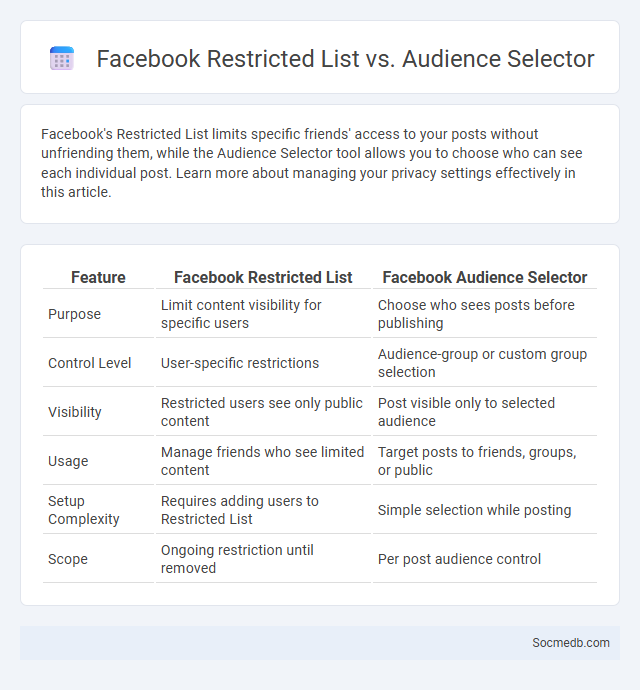
Photo illustration: Facebook Restricted List vs Audience Selector
Facebook's Restricted List limits specific friends' access to your posts without unfriending them, while the Audience Selector tool allows you to choose who can see each individual post. Learn more about managing your privacy settings effectively in this article.
Table of Comparison
| Feature | Facebook Restricted List | Facebook Audience Selector |
|---|---|---|
| Purpose | Limit content visibility for specific users | Choose who sees posts before publishing |
| Control Level | User-specific restrictions | Audience-group or custom group selection |
| Visibility | Restricted users see only public content | Post visible only to selected audience |
| Usage | Manage friends who see limited content | Target posts to friends, groups, or public |
| Setup Complexity | Requires adding users to Restricted List | Simple selection while posting |
| Scope | Ongoing restriction until removed | Per post audience control |
Understanding Facebook's Privacy Controls
Facebook's privacy controls offer customizable settings that allow you to manage who can see your posts, personal information, and activity on the platform. You can adjust options such as profile visibility, friend requests, and data sharing preferences to enhance your account security. Regularly reviewing these settings ensures your social media experience aligns with your privacy expectations and protects your personal information from unwanted access.
What is the Facebook Restricted List?
The Facebook Restricted List allows you to limit what certain friends can see on your profile without unfriending them, effectively controlling your privacy on the platform. When you add someone to this list, they only see content you make public or posts you tag them in, helping you manage your online presence and interactions. Your use of the Restricted List ensures selective sharing while maintaining connections with acquaintances or colleagues.
How the Audience Selector Works on Facebook
The Audience Selector on Facebook allows you to control who sees your posts by choosing specific groups such as Friends, Public, or Custom lists. This feature uses privacy settings to segment your audience, ensuring your content reaches the right people based on demographics, interests, or previous interactions. Your ability to tailor visibility enhances engagement and protects your privacy across the platform.
Differences Between Restricted List and Audience Selector
Restricted List on social media limits specific users from seeing your posts without unfriending them, offering a discreet control over content visibility. Audience Selector allows you to choose who sees each post by selecting groups or individuals, providing flexible customization for Your shared content. Understanding these tools enhances Your control over privacy and audience engagement on platforms like Facebook.
Use Cases for the Facebook Restricted List
The Facebook Restricted List allows you to limit what certain friends can see on your profile without unfriending them, making it ideal for managing privacy with acquaintances, coworkers, or distant family members. You can share posts, photos, or updates publicly or with your close friends while those on the Restricted List only see content you share publicly. This feature helps you control your online presence and maintain boundaries without cutting ties.
Benefits of Facebook Audience Selector
Facebook Audience Selector enhances your marketing precision by allowing targeted ad delivery based on demographics, interests, and behaviors, increasing engagement rates. This tool optimizes ad spend by reaching the most relevant users, improving conversion rates and return on investment. You gain actionable insights through segmented audience data, enabling tailored content strategies that resonate effectively with specific groups.
Managing Friend Interactions: Restricted List vs Audience Selector
Managing friend interactions on social media effectively protects your privacy and controls what content your connections can see. The Restricted List limits specific friends to viewing only your public posts, preventing them from seeing private updates without unfriending. Using the Audience Selector allows you to customize post visibility for different groups instantly, giving you precise control over who interacts with your shared content.
Privacy Implications of Each Feature
Social media platforms collect extensive personal data through features like location tagging, facial recognition, and targeted advertising, raising significant privacy concerns. Features such as story sharing and live streaming often expose users to unintended audiences, increasing risks of data misuse and identity theft. Privacy settings frequently offer limited control, making it essential for users to understand and manage permissions for data sharing and access.
Step-by-Step Guide to Using Restricted List and Audience Selector
Using the Restricted List on social media platforms helps limit the visibility of your posts to specific users without unfriending them, enhancing privacy control. The Audience Selector tool allows precise targeting by choosing who can see your content, enabling tailored sharing with friends, public, or custom groups. Combining both features optimizes your social media experience by managing audience engagement and safeguarding personal information efficiently.
Choosing the Right Privacy Setting for Your Needs
Choosing the right privacy settings on social media ensures that your personal information is protected according to your preferences and risk tolerance. Reviewing platform-specific options such as account visibility, data sharing, and ad preferences allows you to tailor your experience and minimize unwanted exposure. Regularly updating these settings helps maintain control over who can see your content and interact with your profile, safeguarding your online presence.
 socmedb.com
socmedb.com